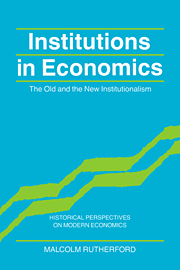1 - Definitions and issues
Published online by Cambridge University Press: 12 January 2010
Summary
Throughout the history of economic thought, attempts have been made to incorporate issues relating to institutions and institutional change within the discipline. The most obvious example is that of the American institutionalist tradition of Veblen, Mitchell, Commons, and Ayres. But institutional analysis of various kinds can also be found in the works of classical economists such as Adam Smith and J. S. Mill; members of the German, English, and American historical schools; Marx and other Marxians; Austrian school members such as Menger, von Wieser, and Hayek; Schumpeter; and neoclassicals such as Marshall.
This book concentrates on the two major traditions of institutionalist thought in economics. The first is the American institutionalist tradition that began at the turn of the century and has continued uninterrupted (although with large swings in popularity and prestige) to this day. The second is a more recent development, but one that can be seen as a revival and considerable expansion of the institutionalist elements to be found in classical, neoclassical, and Austrian economics, elements that had fallen into neglect in the intervening period. The former tradition is now often called the “old” institutional economics, or OIE, while the latter is usually called the “new” institutional economics, or NIE.
The old and the new institutionalism
The old institutionalism consists of that tradition of thought associated with Thorstein Veblen, Wesley Mitchell, John R. Commons, and Clarence Ayres, and with the more recent contributions of Allan Gruchy, Wendell Gordon, Marc Tool, and the many others represented in the pages of the Journal of Economic Issues.
- Type
- Chapter
- Information
- Institutions in EconomicsThe Old and the New Institutionalism, pp. 1 - 6Publisher: Cambridge University PressPrint publication year: 1994
- 1
- Cited by

